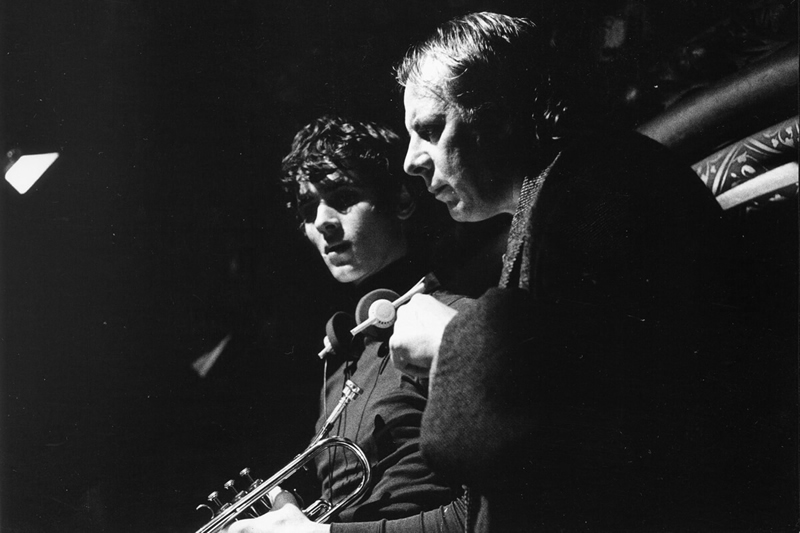
TIERKREIS (ZODIAC) supplement
Stockhausen Complete Edition on CD
Since 1991, a complete edition of all recordings in which Karlheinz Stockhausen has personally participated is being released on compact discs. Each CD in this series is identified by Stockhausen's signature followed by an encircled number. The numbers indicate the general historical order of the works.
Stockhausen realised the electronic music and participated in these recordings as conductor, performer, sound projectionist, and musical director. He personally mixed down the recordings, mastered them for CDs, wrote the texts and drew the covers.
- The compact discs may be obtained from the Stockhausen-Verlag: Kettenberg 15, 51515 Kuerten, Germany (www.stockhausenCDs.com).
Karlheinz Stockhausen
Stockhausen's TIERKREIS (ZODIAC)
Christel Stockhausen
Supplementary text
Introduction, Analytical Description and Performance Instructions
In 1975, 12 melodies were composed for the work MUSIK IM BAUCH (Music in the Belly) for 6 percussionists and music boxes, one for each sign of the zodiac. Stockhausen:
I began to busy myself with the 12 human characters of the ZODIAC of which I had until then only a vague idea. In inventing each melody, I thought of the characters of children, friends, and acquaintances who were born under the various star signs, and studied the human types of the star signs more thoroughly. Each melody is now composed with all its measures and proportions in keeping with the characteristics of its respective star sign, and one will discover many legitimacies when one hears a melody often, and exactly contemplates its construction . . . Each melody is composed in such a way that one should play it at least 3 times. When one wishes to listen to several or all of them one after another, then each should be played 3 or 4 times in succession.
Each of the melodies, therefore, has its own character, with its own central pitch. AQUARIUS (the star sign of Julika, Stockhausen's youngest daughter, to whom he dedicated MUSIK IM BAUCH) is the first melody, and E - flat is its central pitch; E is the central pitch of PISCES, etc. chromatically upward. LEO is in the middle and its central pitch is A, and finally, CAPRICORN'S central pitch is D.
For a performance of MUSIK IM BAUCH, the performers choose three melodies. Everything that they play is comprised of these melodies. In the marimba part, one melody is stretched over the entire duration of the performance. In the klangplatten (sound plates), the three chosen melodies are played one after another, also stretching over the entire length of the performance. The other instruments interpret motives and single pitches from these melodies, and play the melodies simultaneously in various tempi.
For the world premiere performed by Les Percussions de Strasbourg in Royan, France on March 28, 1975, the melodies LEO - AQUARIUS - CAPRICORN were chosen ( they are played in this order - 16 times slower than the tempi for music boxes - by the klangplatten, whose pitches serve as time orientation for three other players ). The same sequence of melodies was chosen for the record production of MUSIK IM BAUCH, which was released in 1977 by Deutsche Grammophon. The 12 melodies of the zodiac played by music boxes are on the "B" side of the record.
Independent of MUSIK IM BAUCH, there is a version of TIERKREIS ( ZODIAC ) for any melody instrument and / or chordal instrument. In addition, there are versions for soprano, alto, tenor, baritone, bass with chordal instrument, a version for chamber orchestra ( clarinet, horn, bassoon, and strings ) which can also be performed with alto or tenor, or soprano and / or bass ( the vocal parts must be specially ordered ); and there is a version for trumpet, soprano, bass clarinet, and bass which resulted in connection with the work, SIRIUS. All of the above scores are published by the Stockhausen-Verlag, 51515 Kürten, Germany; all versions with voice exist up to now in German, English and Italian . The texts, which were written by the composer, describe the most prominent charac teristics of the 12 human types.
When performing these melodies, instrumentalists or singers should consider various possibilities of interpretation to make the structures clearly perceivable, and to make them interesting for the listeners. Since each melody must be played three or four times in succession, the interpreter has many possibilities for variation during the repetitions. The following variations are possible:
a) dynamic nuances, either within a melody or from repetition to repetition;
b) change of articulation (staccato, portato, legato)
c) use of various octave registers, either on the same instrument or on auxiliary instruments (for example, flute, piccolo, alto flute)
d) duet interpretation: when a chordal instrument accompanies a melody instrument or a singer, variation can be achieved by the arrangement of solos and duets.
e) melodic variation: by leaving out certain pitches of a melody, its structure - in terms of rhythm, interval successions, introduction of new pitches, repeated pitches (principle of 12-tone music) - can be made clear. Rhythmic variations can be made by playing/ singing the entire rhythm of a melody using only the central pitch, or by playing/ singing the central pitch only at the places where it originally occurs, replacing all other pitches by rests. This last possibility can, for example, be used in LEO.
f) clarification of the interval sequence: the first occurrence of each interval can be especially emphasized (in certain melodies - LEO for example - all the different intervals, both rising and falling, are melodically related to the central pitch). Alternatively play only the new intervals, replacing their recurrences with exact rests (in the given rhythm of course).
g) dissection of a melody: certain sections of melodies may be emphasized by leaving out others. The resulting spaces between sections can be bridged either by holding the last pitch of the previous phrase or by an exact rest during which the player remains motionless.
All of these possibilities are valid both for solo and for duet versions, the latter having the additional freedom to combine several variations.
The choice of variations is left to the interpreters, but they should only use them to clarify the inner structure and to bring out the distinctive characteristics of the melodies. In planning a version, it is essential to consider the entire cycle in order that the methods of variation do not become repetitive.
In addition, the lengths of pauses between melodies should be varied. One could replace a pause which divides two melodies in a special way by weaving two melodies together (see example CAPRICORN - AQUARIUS).
Two versions which have already been performed are given below as examples. The first is for a solo melody instrument (flute), the second is for soprano and piano. The latter also demonstrates how a version for melody and harmony instrument can be made. The different languages could in this case be replaced by different timbres or groups of timbres.
Version for flute solo
1. AQUARIUS (3 times)
a) mezzoforte
b) piano, octave lower
c) pianc  forte
forte  piano, octave lower.
piano, octave lower.
2. PISCES (3 times)
a) pianissimo, only play fragments
b) forte
c) alternate fortissimo with pianissimo in waves.
In contrast to most of the other pieces, this piece has a completely equal second voice. One could imagine two fishes in alternating movement. It would therefore be appropriate for two melody instruments to play here.
3. ARIES (4 times)
a) forte
b) piano
c) pianissimo, octave lower
d) fortissimo, octave lower
or a second version for piccolo:
a) mezzopiano staccato, octave lower, march-like
b) pianissimo  fortissimo, octave lower, march-like
fortissimo, octave lower, march-like
c) forte, register as notated.
4. TAURUS (3 times)
a) forte
b) piano, octave lower
c) forte staccato and near the end, molto ritardando, octave lower.
5. GEMINI (3 times)
a) piano, octave lower
b) piano  forte, register as notated
forte, register as notated
c) fortissimo, register as notated
or a second version for piccolo:
a) pianissimo staccato and trills on as many pitches as possible, octave lower
b) forte, octave lower
c) forte with accelerando to the end, last pitch fluttertongue, long pause until next piece.
6. CANCER (4 times)
a) mezzo piano
b) piano
c) piano, octave lower
d) pianissimo, octave lower; only play fragments
or a second version for alto flute:
a) piano
b) pianissimo
c) pianissimo, become slower
d) ritardando molto; stop in the first line with sustained F- sharp, barely audible;
all this in the lowest register of the alto flute!
In this piece, it is interesting to note that the first time each new pitch of the
12 - tone row appears, it always precedes a rest.
7. LEO (3 times)
a) play only the central pitch A as it is notated, with exact rests replacing the other pitches, piano
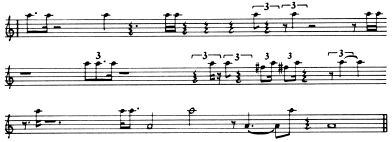
b) pianissimo  forte
forte
c) forte.
8. VIRGO (3 times)
a) forte
b) forte  piano. octave lower
piano. octave lower
c) only play the new pitches in their longest durations, With exact rests, octave lower.

9. LIBRA (4 times)
a) pianissimo, only "touch" the pitches, octave lower
b) mezzo piano, with indicated durations, octave lower
c) forte, register as notated
d) omit segments, play remaining segments forte, register as notated.
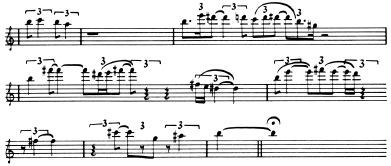
(An accidental refers only to the note which it precedes; natural signs serve only to facilitate reading. This also applies to the printed versions of TIERKREIS.)
10. SCORPIO (3 times)
a) forte
b) piano
c) forte
Play very bitingly and staccato (well suited for piccolo).
11. SAGITTARIUS (4 times)
a) piano
b) piano  forte, changing the register from measure to measure, beginning with the normal range: the measures in the lower register in legato, the measures in the higher register staccato
forte, changing the register from measure to measure, beginning with the normal range: the measures in the lower register in legato, the measures in the higher register staccato
c) forte
d) play only the first measure with a large decrescendo and ritardando; final pitch G pianissimo with fermata.
12. CAPRICORN (4 times)
a) forte
b) play all new intervals
c) forte
d) interweaving of the melodies CAPRICORN and AQUARIUS: this possibility is less effective at the end of the TIERKREIS (since it
then leads back to the beginning). 1 used it only when I started the cycle with a piece other than AQUARIUS; i.e. when AQUARIUS followed CAPRICORN.
musical illustration of 12b ):
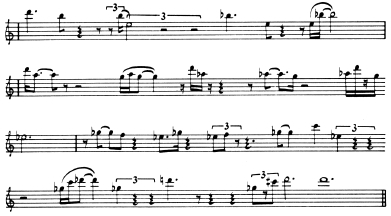
musical illustration of 12b ):

dynamics of the fragments:
CAPRICORN

AQUARIUS

Version for soprano and piano
In the title TIERKREIS for a melody and / or harmony instrument, the "harmony instrument" is deliberately unspecified. Harpsichord, celesta, harmonium, organ, any type of electric organ or chordal synthesizer, harp, Vibraphone (perhaps together with marimbaphone ), etc. may be used alone, mixed or alternatingly, instead of the usual piano. Versions for instruments with many different stops or registrations are particularly suitable for unlocking the structures and characterizing the human types through the disposition of timbres. Stockhausen's TEXTE Volume 4 (in German, DuMont Buchverlag, Cologne 1978) is recommended for further study, since this volume contains explanatory texts about the TIERKREIS, sketches for the 12 melodies, and the sung texts (which describe the characteristics of the 12 human types).
(S = Soprano, P = Piano)
1. AQUARIUS (4 times)
a) Duet, German, mezzo forte, P senza 8va, pedal held through the following solo of the
b) S, English, pianissimo, secretive, breathy.
c) P, fortissimo, 8va.
d) Duet, 2nd verse English, mezzo piano.
New pitches in P forte, all others softer; P 8va.
Both end together, as notated!
musical example for d) new pitches in P (the pitches given here are from the instrumental version, not the transposed version for soprano):

2. PISCES (3 times)
a) P forte to fortissimo, 8va; pedal held through the following repetition with the
b) S, English, piano; P plays 4 inserts mezzo forte, 8va:
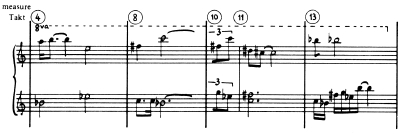
c) Duet, German, dynamics as notated;
P senza 8va; last tone by soprano  as long as possible, let
as long as possible, let
P fade away completely.
3. ARIES (3 times)
a) Duet, German, S forte; P mezzo piano and 8va.
b) P fortissimo, 8va.
c) Duet, English, S mezzo piano; P pianissimo, left hand piu pia
nissimo, meno pedal; P senza 8va; at end leave out last quarter note ( upbeat).
4. TAURUS (4 times)
a) S English, piano.
b) Duet, 2nd verse English, forte; P senza 8va.
c) P forte-fortissimo, senza 8va. staccatissimo except for:
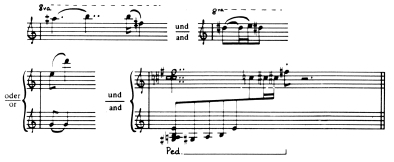
d) Duet, 2nd verse German, pianissimo, semplice: P left pedal;
S last note with fermate, P right pedal until beginning of GEMINI.
5. GEMINI (3 times)
a) P fortissimo 8va.
b) Duet, German, S forte; P piano, 8va.
c) Duet, English, 8 mezzo piano / piano; P piano / pianissimo, left hand only and 6th measure, 5th quarter note both hands, senza 8va; S and P play last note with fermata, end together.
6. CANCER (4 times)
a) Duet, English, S mezzo piano (as notated); P piano  forte
forte 
piano, both hands equally loud: P 8va, leave out lst eighth-note of triplet. hold pedal through the following solo of the
b) S, German, mezzo piano, after the 5th rest  to fortissimo on high F and
to fortissimo on high F and  to mezzo forte before the beginning of the 8th
rest, both ending-fragments mezzo piano and piano.
to mezzo forte before the beginning of the 8th
rest, both ending-fragments mezzo piano and piano.
c) Duet, English, pianissimo  mezzo piano
mezzo piano  pianissimo; P senza 8va, left pedal; S holds last note as long as possible during the
following solo of the
pianissimo; P senza 8va, left pedal; S holds last note as long as possible during the
following solo of the
d) P, dynamics the same as for S in b) above, senza 8va.
7. LEO (3 times)
a) P, right hand forte and left hand piano.
b) Duet, English, S pianissimo  fortissimo: P piano
fortissimo: P piano  fortissimo,
left hand always much softer; S last 5 notes 8va; P senza 8va, hold
everything with the pedal through the following solo of the
fortissimo,
left hand always much softer; S last 5 notes 8va; P senza 8va, hold
everything with the pedal through the following solo of the
c) S, German, piano; P only 3 inserts senza 8va:

End together!
8. VIRGO (4times)
a) Duet, English, 8 mezzo forte, P forte, left hand softer, especially in the lower register; senza 8va.
b) P, fortissimo, senza 8va. hold everything with the pedal into the
c) Duet, 2nd verse English, S piano; P mezzo piano, 8va; S holds the last note as long as possible during the following solo of the
d) P, mezzo forte, ending  forte, 8va; with fermata fading away as long as possible.
forte, 8va; with fermata fading away as long as possible.
9. LIBRA (4 times)
a) S, English, pianissimo  mezzo piano.
mezzo piano.
b) P mezzo forte, senza 8va.
c) Duet, German, 8 piano; P mezzo piano, senza 8va.
d) Duet, English, pianissimo, S does not sing 3rd and 5th measures, but instead holds the preceding pitch through the entire measure B, then F - sharp); P 8va; ending: sustain everything with the pedal, then end together.
10. SCORPIO (3 times)
a) Duet, English, S fortissimo; P forte, senza 8va.
b) P, fortissimo, 8va.
c) S, German, fortissimo (P always with pedal, so that voice always resonates in the instrument).
11. SAGITTARIUS (4times)
a) Duet, German, S mezzo forte; P mezzo piano, senza 8va.
b) Duet, English, pianissimo, like an echo; P left pedal, senza 8va;
S holds last pitch for as long as possible during the following solo of the
c) P, piano, from the middle of the 2nd system cresc.  forte, senza 8va.
forte, senza 8va.
d) P only plays lst measure, forte > piano, molto ritardando, 8va; sustain everything with the pedal.
12. CAPRICORN (3 times)
a) P, piano, 8va; hold everything with pedal during the following solo of the
b) S, Italian, mezzo piano; P chords forte (let ring) on "firmament" and "light", 8va;

c) Duet, English, forte, from the middle of the 2nd line mezzo forte  fortissimo (until the word "Sirius"), senza 8va.
fortissimo (until the word "Sirius"), senza 8va.
Translation: Suzanne Stephens